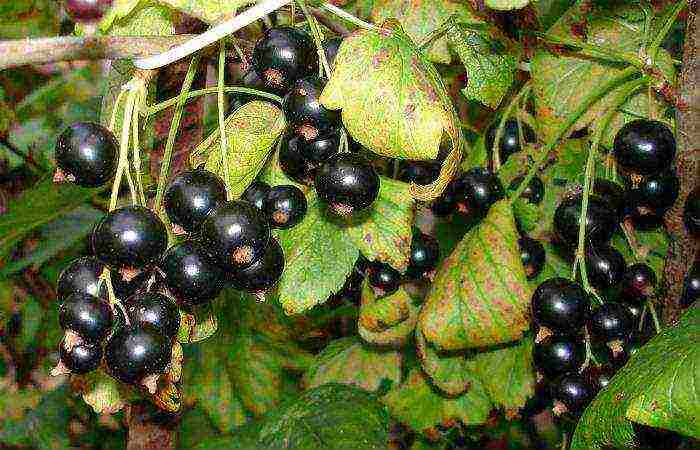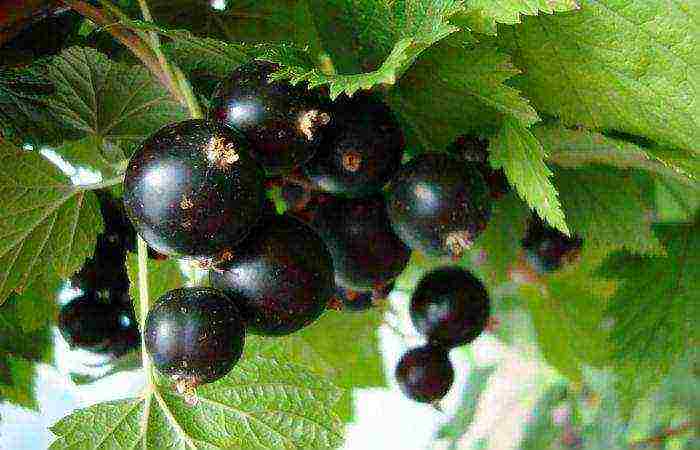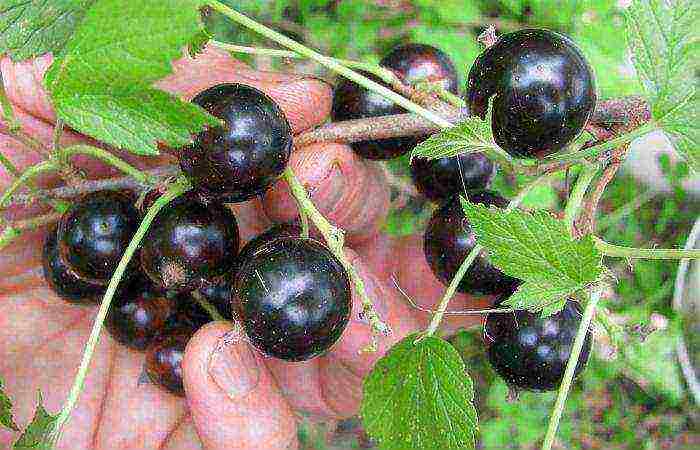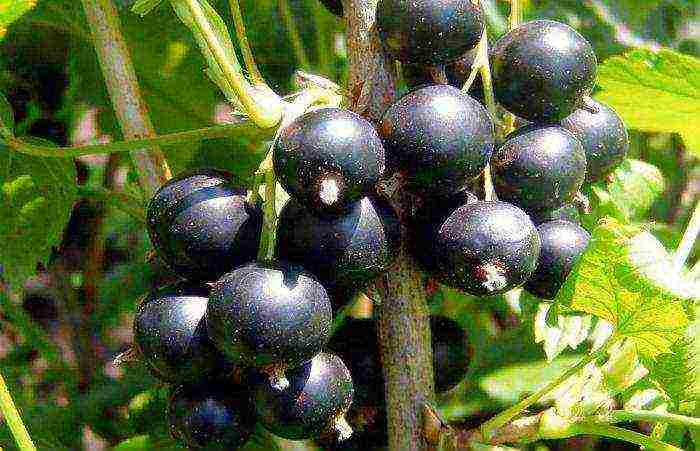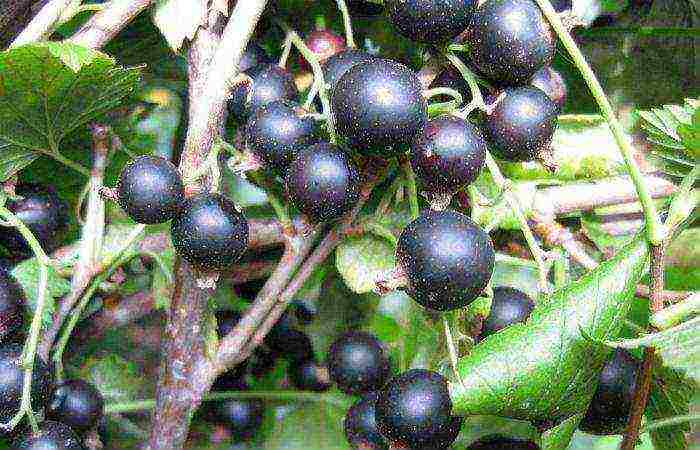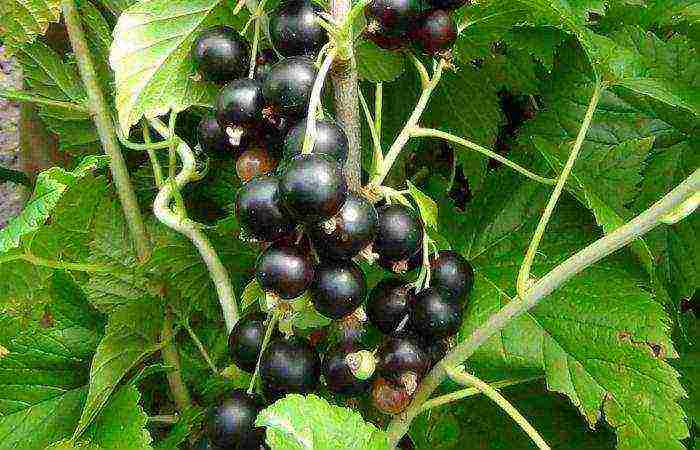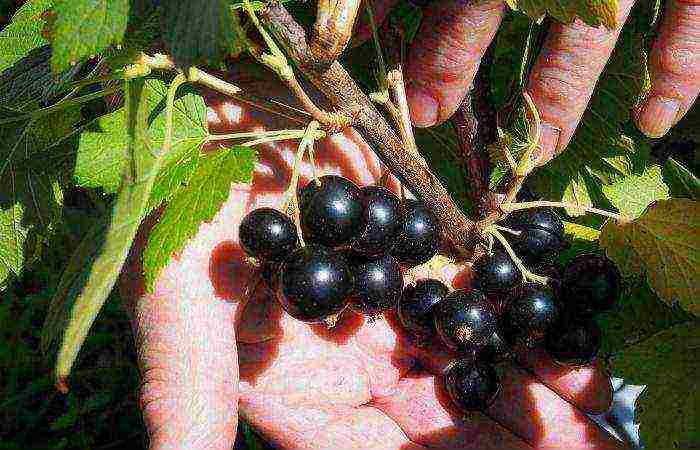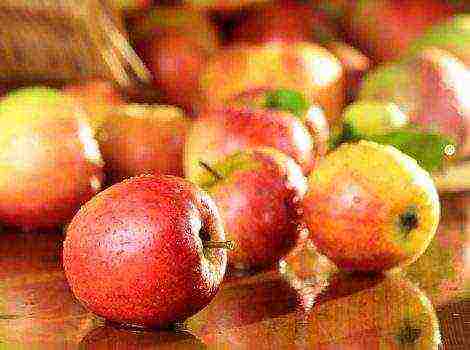Content
- 1 Choosing varieties for central Russia
- 2 Currant for Siberia
- 3 What are the largest-fruited varieties?
- 4 The most resistant varieties
- 5 Gourmets also have plenty to choose from
- 6 What's new for residents of the Moscow region?
- 7 Conclusion
- 8 An excellent pupil
- 9 Nina
- 10 Bagheera
- 11 Triton
- 12 Green haze
- 13 Selechenskaya
- 14 Pearl
Throughout Russia, black currant grows near every house. Undemanding to the composition of the soil, accustomed to harsh winters, it yields even in the subarctic zone... This garden culture bears fruit even in Yakutia and the Khibiny, reached Sakhalin in the east and Krasnodar Territory in the south.
She inherited such a universal adaptation to the whims of the weather from a wild ancestor - the forest currant. There are a lot of varieties and varieties, so it is very difficult for a novice gardener (and not only) to make a choice.
Choosing varieties for central Russia
 Early variety of black currant Exotic
Early variety of black currant Exotic
What are the differences between the varieties:
- By appointment,
- Ripening terms,
- The size of the berries,
- Productivity,
- The taste of berries
- Resistance to diseases and pests,
- Winter hardiness ...
It is very easy to understand the purpose of the variety:
- berries are tasty on their own - this is a dessert variety,
- thin-skinned, but too sour - boil jam or grind with sugar;
- berries with a dense strong skin are frozen,
- universal (understandable).
In order not to be mistaken, it is necessary to choose only zoned varieties.... Only on such bushes can you get a high yield stably and without much effort.
Ripening terms, size of berries, their taste may differ not only from the region of cultivation, but even from watering or soil composition. Already at a distance of more than 200 kilometers, the characteristics of the variety can change significantly.
If you live in the middle lane, you should take a closer look at these varieties:
| Curiosity, Selechinskaya, Exotic, Openwork, Summer resident, Orlovia, Exotic |
| Black pearl, Loyalty, Perun, Green haze, Zusha |
| Kipiana, Vigorous, Venus, Mermaid |
Among the fruit-bearing ones, the Selechinskaya, because he combined the best qualities of his ancestors - wild currants and gooseberries.
Most varieties have an Achilles heel - they cannot grow without abundant watering. But Selechenskaya calmly copes with both summer drought and frosty winters, which makes its choice suitable for any region of Russia.
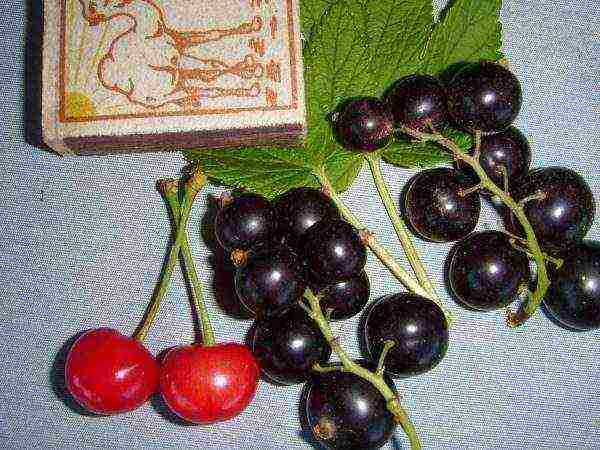 An early variety of black currant Selechenskaya
An early variety of black currant Selechenskaya
To all this, also add five kilograms from a bush of large berries the size of a cherry... There are no special advantages in varieties intermediate between early and late ones. They give fewer berries, and this is not because the varieties are not good enough.
It's just that the period of their fruiting falls on the period of summer heat and dry wind.
The main purpose of these varieties is to fill a niche in front of the later, most productive varieties.
Ripening of late varieties of berries lasts from late July to. the end of autumn. Wherein the Kipiana variety has a yield of up to 5 kg and is resistant to powdery mildew and is not afraid of kidney mites.
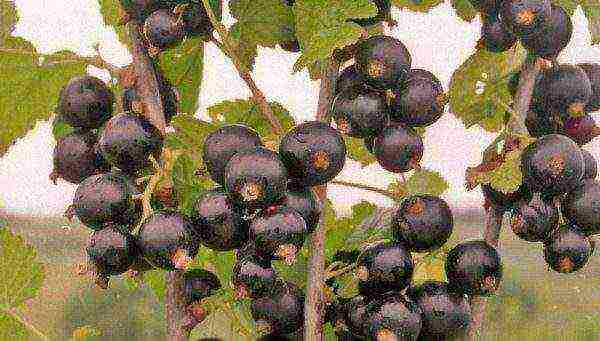 Late black currant Kipiana
Late black currant Kipiana
Vibrant yields late, but these berries can compete even with grapes in size - even 8 grams... There is a known case when an experienced gardener had a berry reached the size of a metal ruble!
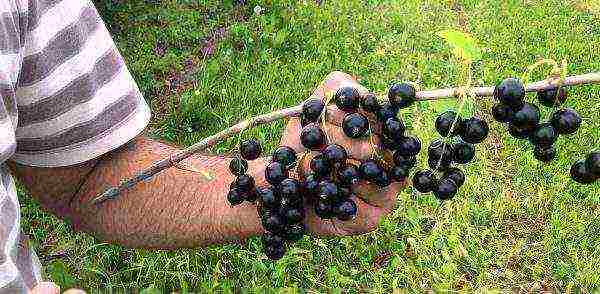 Late variety of black currant Yadrenaya
Late variety of black currant Yadrenaya
The Viper bush usually yields almost 4 kilograms of berries.... The popularity of the variety is also due to its resistance to pests and fungal diseases.
Currant for Siberia
Siberia is known not only for its harsh winters, but also for its hot dry summers. These stressful weather conditions are easily tolerated by the zoned Siberian varieties:
| Lama, Nika, Gift to Kuzior |
| Altayanka, Agatha, Galinka, Rita, Spherical, Fun, Prestige, Ksyusha |
| Mila, Harmony |
New varieties successfully withstand not only frost, but also arid heat. They are able to withstand major fungal diseases and insect pests.
In terms of early maturity, the specified varieties also set records: the first harvest from the currant bush of the new Nika variety reaches 1.2 kilograms.
 Nick's early blackcurrant variety
Nick's early blackcurrant variety
Berries of Siberian currant Large-fruited Litvinova even reach 6 grams!
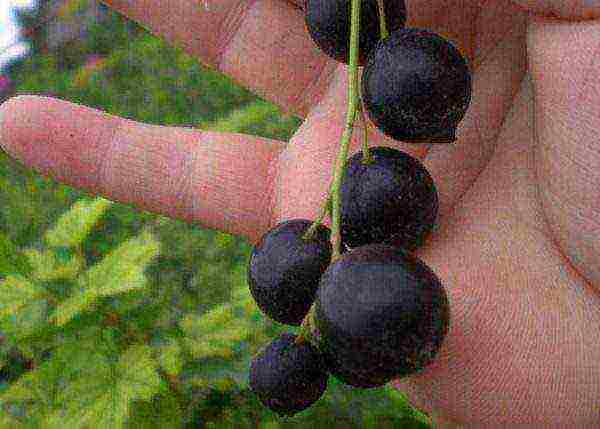 Black currant Large-fruited Litvinova
Black currant Large-fruited Litvinova
What are the largest-fruited varieties?
Undoubtedly, varieties of unusually large berries will become the leaders of the list.
| Vigorous | medium late variety for universal use berries from 3 to 8 grams non-uniform, yield 3-6 kilograms per bush, non-uniform fruits, aging quickly |
| Dobrynya | universal purpose, bears fruit in the second half of July, berries up to 7 grams are also non-uniform, almost five kilograms can be removed from the bush |
| Selechenskaya-2 | universal variety, bears fruit in early July. Berry picking - up to 5 kilograms per bush |
The best large-fruited varieties: Vigorous, Selechenskaya, Globus, Pygmy.
When choosing a super-large-fruited variety, one should not forget that usually such plants require additional feeding and watering, especially in dry summers and if they are planted on sandy soils.
The most resistant varieties
They practically do not get sick, which means - the harvest is ecologically cleanest among the varieties:
- drought tolerant - Dobrynya, Gulliver, Izumnaya;
- disease resistant - Sibylla, Gross, Gamma, Gulliver, Sevchanka, Globus, Muravushka;
- frost-resistant - Sibylla, Venus, Romance, Globe, Pearl, Rhapsody, Vigorous;
- pest resistant - Orlovia, Kipiana, Grazia, Gamma.
Gourmets also have plenty to choose from
If the score is higher than 4.5 points, the variety is assigned to the dessert category: Centaur, Perun, Selechenskaya, Selechenskaya-2, Nadia, Venus, Oryol waltz, Slastena, Beaumond, Nestor Kozin, Tisel, Uralskaya sweet, Raisin, Black eye.
The Iziumnaya variety has an interesting feature: after ripening, the berries do not crumble from the stalk, but gradually "rave", hence the name of the variety.
 Black currant Raisin
Black currant Raisin
The best of the early varieties - Pearl, Black Boomer, Raisin, Legend.
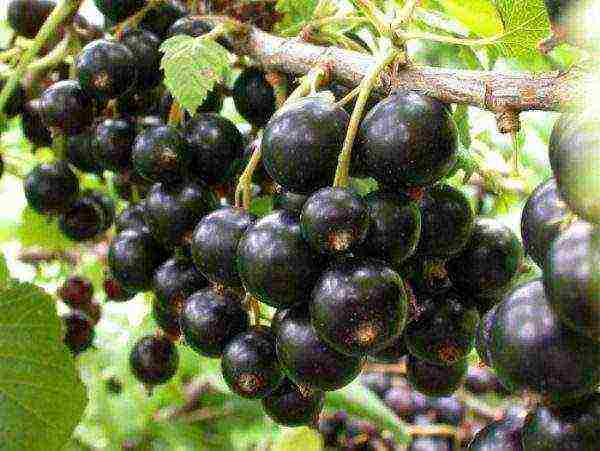 Currant Black Boomer
Currant Black Boomer
Lazy person - late variety with very large berries up to 6 grams.
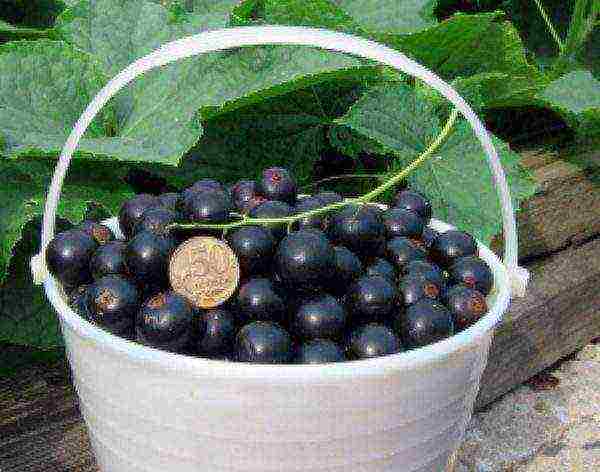 Blackcurrant Lazy
Blackcurrant Lazy
What's new for residents of the Moscow region?
The weather in the Moscow region is characterized by relatively mild winters and rather warm, humid summers. This is the climate that black currants like. However, the soil composition differs even in the districts of the Moscow region.
It is necessary to select varieties not according to yield or taste, but exclusively, adapted to the specifics of the soil composition of the region.
The most famous varieties among summer residents: Veloy, Memory Lisavenko, Sudarushka, Dobrynya, Yadrenaya.
To feast on berries all season, you must choose from the following varieties:
| Sevchanka, Nara, Moscow black, Dar Smolyaninova, Golubichka, Selechenskaya, Selechenskaya-2 |
| Dobrynya, Green haze, Darkie, Oryol serenade, Daughter, Izmailovskaya, Paulinka, Perun |
| Vologda, Lazy, Veloy |
It should be noted that late varieties for the Moscow region are far from the best choice. Summer residents simply may not have time to take advantage of all the best qualities of the same, for example, Lazy - the berries may not ripen.
The Yadrenaya variety, as already noted, was highly appreciated by summer residents for many literally unique qualities:
- high yield,
- very large plum berries,
- compact bush,
- self-fertility,
- winter hardiness,
- early maturity.
Even if you are overwhelmed by the size and flavor of the berries, there are still some characteristics you need to figure out.
What characteristics should you pay attention to first of all:
- self-fertility (no additional pollinator is needed),
- susceptibility to diseases and pests,
- resistance to spring frosts and other weather factors.
If you plant several varieties nearby (even self-fertile ones), there will be much more berries.
Therefore, stress-resistant Gulliver will not create problems with weather whims, and Smolyaninova's gift will delight you with an early harvest even without chemical treatments for pests and diseases.
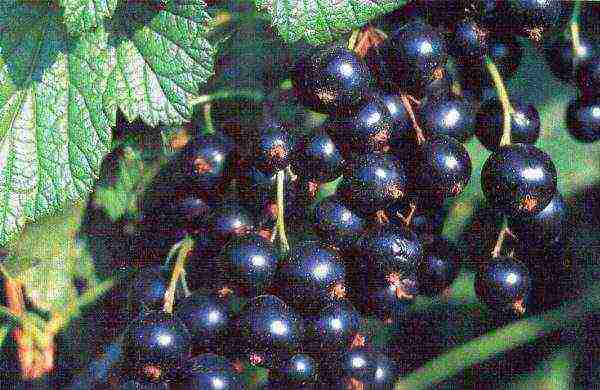 Black currant gulliver
Black currant gulliver
Another gift for fans of ecological products - variety Orlovskaya serenada, which is practically not afraid of kidney mites , and from fungal diseases - powdery mildew.
 Black currant Oryol serenade
Black currant Oryol serenade
Variety Selechenskaya-2 with its increased ecological plasticity, will not be afraid of lack of water and unsuitable soils... As a result, the summer resident will receive from the bush his required 5 kilograms of berries the size of a cherry.
Conclusion
It is very difficult to choose the right variety of black currant bush., but the correct solution to this problem for an ordinary summer resident exists. This is to acquire zoned modern varieties of different ripening periods. Their high yield, unpretentiousness, harmonious taste has already found confirmation in personal plots throughout the country.
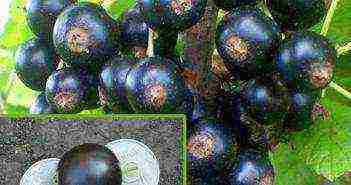
Black currant is a berry crop that any self-respecting gardener grows on his site. The fruits of these shrubs are tasty and healthy, both fresh, only from a bush, and canned. The most popular are those varieties of black currant, which are distinguished by good yields and resistance to all sorts of pests and diseases. Let's take a look at how to choose the right blackcurrant shoot, how to plant and care for it.
How is the care of red currants in the spring, you can find out from this article.
For the middle lane

If you decide to start growing black currant or increase the number of existing bushes on your site, the first thing to do is to choose a variety. Which one to prefer?
Taking into account the fact that about 200 varieties of currants have been bred in Russia, the choice is not so simple. Moreover, in the descriptions of varieties, breeders mainly cite only advantages. So, for central Russia I would like to highlight the following varieties:
For Siberia
The following currant varieties are best suited for Siberia: Druzhnaya, Zoya, Biya.
Druzhnaya grade... Possesses good winter hardiness - tolerates the most severe frosts. It gives high yields and has a high density of berries from the bush. From a bush, from 2 to 5 kilograms of berries are obtained. The fruits are sweet and sour. Ripens in medium terms. Not resistant to powdery mildew. 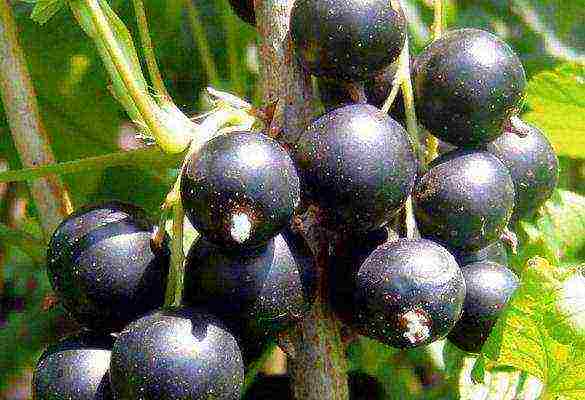
Zoya... Winter hardiness is not very high - the rudiments of flowers can be damaged. The bushes have a high yield density and are not very large in size. It has an early ripening period and is even ahead of Druzhnaya. The variety can be affected by a disease such as septoria. 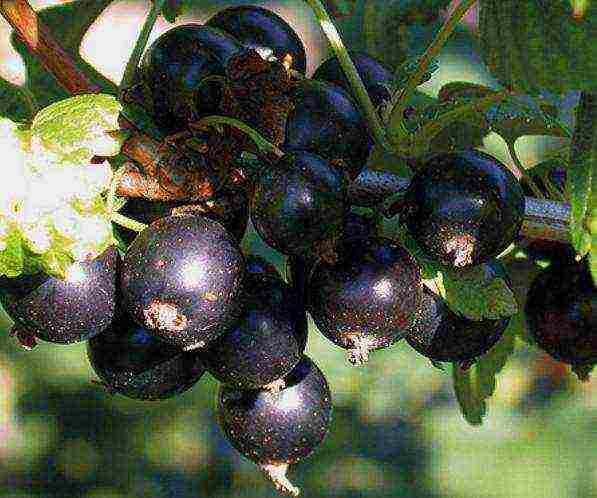
Biya... It has a high winter hardiness of flower rudiments, but low - of the vegetative system. Therefore, the bushes should be covered with snow. Ripening is later than that of the Druzhnaya variety. May be affected by septoria and columnar rust. In the photo - the Biya variety:
Also for Siberia, the recently bred varieties are recommended: Seedling of the Golubki, Dikovinka, Chudesnitsa, Lyubimitsa Altai.
How does the care of black currants in the spring, you can find out from this article.
The choice of the appendix and planting
Currants are a crop that cannot be propagated by seeds. She does not inherit all the qualities of the mother bush. If you buy a scion from the market or from a breeder, pay attention to the following signs. The scion must be 2 years of age. He must have a developed root system - he must have three skeletal roots. If the currants are sold in a pot, it is advisable to pull it out from there. And it is better to take a zoned variety of currants - grown specifically for your places.
The video shows the varieties of the largest black currant:
If you already have currants in your garden, the best way to propagate them is with a cutting. The survival rate is about 90 percent - and this is a good result. Cuttings can be either green or lignified. They are harvested from the main shoots that come from the main bush. In this case, the bushes should be no younger than three years of age. Up to 20 cuttings can be obtained from one plant. The bushes from which the cuttings are taken must necessarily be high-yielding and without signs of disease - first of all, they must not be damaged by powdery mildew.
What are the remontant yellow varieties of raspberries, indicated in this article.
Raspberry varieties Yellow Giant reviews and other data of the variety are indicated in the article.
How is the cultivation and care of remontant raspberries, you can watch the video in this article:
It is best to harvest them in the first half of autumn. The average length of the cutting is 15-20 centimeters. And the width is about 0.7 - 0.8 centimeters. The cut must be done with a well-sharpened knife, while about 1.5 centimeters higher than the kidney. You can also use a sharp pruner for these purposes.
Lignified blackcurrant cuttings are usually annual shoots. It is imperative that they are well ripened. After all, the larger and longer the stalk, the more various nutrients it contains.
Rooting cuttingsAfter you have collected many cuttings, the question arises of how to proceed with them further. Before answering this question, do not forget to seal the sections with beeswax or process with molten paraffin.
What's next? There are several options:
- cuttings can be saved until spring... To do this, they are collected in a bundle and sent to the refrigerator.
- planting in the ground without rooting... In the spring, the melt water will wake up the branches - they will take root on their own.
- rooting at home - in an apartment. This method is preferable, as it allows you to identify diseased shoots before you plant them in a permanent place.
Remontant strawberry varieties for Siberia, which are best suited can be found in the article.
How the stratification of strawberry seeds occurs at home is indicated here.
growing strawberries using Dutch technology video and other data are indicated in the article here: Methods
What are the best ways to root cuttings?
- cooked roots are dipped in water and await their rooting... The roots will appear in 10 days. Experienced gardeners also advise adding a growth stimulant purchased in a special store to the water - the roots will appear faster and there will be more of them.
- Method "to the newspaper" or burrito... Take a large newspaper, plastic bag, and water. Wrap the cuttings completely in paper. The resulting package must be moistened with water, but not overmoistened. All this must be put in a bag in an upright position, and the top of the bag must be wound around the cuttings. The main task is to ensure that air enters there, but at the same time the contents of the bag are closed. Place the bundle in a dark, cool place - at a temperature of about 18-20 degrees. In three to four weeks, intensive root formation will begin.
- using potatoes... Stick the cuttings about two-thirds into the young, large potatoes. The potatoes will provide them with moisture and all the nutrients they need for rooting. Select a spot on the site and dig a trench there. Pour 5-10 centimeters of sand on the bottom and place the cuttings in the potatoes on the bottom. Fill the trench. Don't forget to water the cuttings!
Planting cuttings in the ground and proper care
Cuttings can be planted permanently in spring or fall. If you are doing it weighty, wait until the soil warms up to about plus 8-10 degrees.
For black currants, you need to carefully select the landing site. She loves windless free areas with fertile and moist soil. It's good that there aren't a lot of weeds there.
How to plant cuttings correctly? We sort them by thickness and plant them in a well-moistened soil in advance to a depth of about 15 centimeters. The distance between the rows should be approximately 20-30 centimeters. After planting, the soil must be compacted. You can immediately fertilize the currants with humus. At first, the soil under the cuttings should not be allowed to dry out. The soil around the currants should be loosened and weeded regularly.
Increasingly, gardeners and summer residents are turning their attention to black currants. They are attracted by the high cost of the produced product, as well as the excellent taste and good medicinal properties of black currant. However, in order to get a good harvest, first of all, you should choose the right plant variety, which will be relevant to the climatic conditions of the growing area.
Openwork
Mid-season blackcurrant variety, self-fertile. Resistant to frost and drought, has good resistance to disease. The yield of an adult bush reaches up to 7 kg of berries. The bush is medium spreading, the branches of the plant are tall and thick, do not need tying. The leaves are powerful and wide, dark green in color. The berries have a slightly flattened, rounded shape; when ripe, they acquire a black color with a shiny sheen. The taste is sweet, with a pleasant sourness.
back to contents ↑ Aleander
Super early blackcurrant variety, yields even in short northern summer conditions. Self-pollinating. It survives well in the harsh Siberian climate, for which it gained great popularity. Abundant fruiting begins only in the third year. Spreading bushes, vigorous. Branches very often spread along the ground, need to be tied up. The berries are large, the skin is slightly rough. The separation is dry. The taste is sweet.
Back to contents ↑ Bagheera
A mid-season blackcurrant variety with good productivity, self-pollinating. Medium resistant to frost and adverse weather conditions. The bush is medium spreading, all covered with dense dark green foliage. The brushes are long and thin. All berries are of the same size, covered with a thin skin, which becomes bright black when ripe. The taste is sweet, slightly sour. Great for canning.
back to contents ↑ Old Man
An early variety of black currant, self-fertile. Resistant to frost and frequent weather changes, it needs abundant watering. It is immune to almost all diseases. Low-yielding. Bushes are compact, dense and tall. The leaves are large, green. The berries are round; when ripe, they acquire a matte black color. The separation is dry. The taste is sweet and sour. The variety is suitable for long-term freezing.
back to contents ↑ Belarusian sweet
Medium early variety of sweet black currant, self-fertile. Its high resistance to frost has earned popularity in the Moscow region. The bush is medium spreading, branches up to 1.2 m high. The leaves are wide, yellow-green. The berries are slightly flattened, large, with a brown-dark color. Delicious and sweet. They are distinguished by a high content of ascorbic acid.
back to contents ↑ Bolero
Medium-early variety of large-fruited black currant, self-fertile. Frost resistance is very high, tolerates a harsh climate well. May be affected by kidney mites. The bush is small, very dense and spreading. The leaves are wide, slightly wrinkled. The brushes are long and thin. The berries are round, rather large, black. The separation is wet. Has a sweet-sour aftertaste and a very persistent pleasant aroma.
back to contents ↑ Venus
Medium late variety of black currant, domestic selection. Meets all the requirements of the difficult Russian climate. It is frost-resistant, easily tolerates heat and drought, and is not affected by diseases. Bushes are medium spreading, tall. With proper care, it produces truly giant berries, up to 6 grams. The taste is sweet. Suitable for consumption raw, used for grinding with sugar in jam.
Back to contents ↑ Vologda
Late variety of black currant, self-pollinating. Poorly tolerates severe winters and early frosts, is very resistant to diseases. The bush of the plant is slightly spreading, medium. The leaves are very large, deeply dissected, green, with a slight blue. The brushes are bent into an arc, of different lengths. With good care, the berries reach a mass of 3.5 grams, when ripe, the fruits become dark black. The separation is dry. The taste is very delicate and sweet.
Back to contents ↑ Memories
Mid-season black currant variety. It has good resistance to frost, among diseases it is weakly resistant only to powdery mildew. Gives a good harvest in the second year after planting. The bush is not tall, medium spreading, with a good harvest it may need to be tied up. The berries are round, large, dull black. They have a persistent aroma and pleasant sweet taste.
back to contents ↑ Delicacy
Mid-season blackcurrant variety, self-fertility is very low. This variety is excellent for the difficult weather conditions of the Urals, as it has excellent frost resistance and is practically immune to diseases. Needs abundant watering. Plants are tall, medium spreading, very dense. The leaves are small but dense. The brushes are thin and long. The berries are medium-sized, flattened, black when ripe. The taste is sweet, dessert. It is widely used in cooking and canning.
back to contents ↑ Curiosity
An early variety of black currant, with high self-fertility. Frost resistance is above average, but this variety has almost no immunity to tick-borne diseases. Poorly tolerates dry weather. It can give a crop already in the year of planting. Bushes of medium height, semi-spreading. The leaves are smallish, light green. The berries are slightly oval, black, pluck without breaking. Has a high taste.
back to contents ↑ Daughter
Late variety of black currant, self-fertile. It tolerates frosts and severe winters well, has good resistance. In bad weather conditions, it needs additional care. The bushes are small, slightly spreading. The leaves are small, light green. Berries are oval, large, with a dense skin, dry separation. Has a very pronounced sweet taste.
back to contents ↑ Dubrovskaya
Late variety of black currant, self-fertile. The variety is especially popular in central Russia. Resistance to any unfavorable conditions is very high; powdery mildew is a rare exception. The plant is compact and undersized. The leaves are wrinkled, dull green. The brushes are slightly bent into an arc. With timely care, the berries grow large, pear-shaped, with a shiny black color. The taste is sweet, with a subtle sourness.
Back to contents ↑ Green haze
Medium late black currant, Self-fertile. Poorly tolerates very cold winters, heat and drought. Has good disease resistance. In favorable years it has a high yield. Slightly spreading, medium-sized bush. The leaves are small and flat, light green in color. Fruits are round, of different sizes, black. The separation is wet. The taste is delicate, sweet.
back to contents ↑ Izumnaya
A medium-ripening blackcurrant variety, low self-fertility. It has high frost resistance, tolerates sharp weather changes well. Resistant to fungal diseases. The bush is low, medium spreading. The berries are large, of the same size, shiny black with a purple tint. The taste is very sweet, little sugar is used for grinding into jam.
back to contents ↑ Kastichai
An early variety of black currant, very high self-fertility. It perfectly tolerates unfavorable weather conditions, but it is strongly affected by frosts. Immunity to diseases is average. The bushes are compact, vigorous, with powerful thick shoots. The leaves are large, dense, slightly wrinkled. The berries are medium-sized, of various sizes. When ripe, a waxy bloom with a bluish tint appears on the black peel. The separation is wet.The taste is sweet and sour, in production it is used for canning.
back to contents ↑ Katyusha
A medium late variety of black currant, bred by Belarusian breeders, self-fertile. It perfectly tolerates the hardships of a harsh climate, is resistant to sudden changes in the weather and to diseases. Abundant fruiting begins only 3 years after planting. Plants are compact, tall. The shape of the fruit resembles olives, large, black in color with a dark blue tint. The separation is dry, the berries do not deteriorate during transportation. The taste is sweet and sour, dessert.
back to contents ↑ Bummer
Late variety of black currant, self-pollination is very low. Possesses good winter hardiness. Young plants are often affected by diseases, and therefore require additional care. Bushes are low, medium spreading. The leaves are large, smooth, dark green in color. The brushes are long and thin. The berries are round, very large, black-brown in color. The separation is dry. The taste is sweet and sour, with almost no aroma.
Back to contents ↑ The Little Prince
An early variety of black currant, medium self-fertility. Suitable for growing in regions with frequent frosts and prolonged droughts. Possesses high resistance to diseases. Gives a good harvest in the second year after rooting. The bush is low, medium spreading. The leaves are large and dense, with a deep dark green color. Brushes are long, often paired. The berries are medium-sized and large, slightly brownish, very juicy, but the separation is dry. The taste is sweet and sour.
back to contents ↑ Heiress
A very early variety of black currant, of domestic selection. Self-fertile. Popular due to its excellent winter hardiness, abundant fruiting, even in unfavorable seasons and low disease susceptibility. The bush of the plant is medium-sized, semi-spreading. Clusters are long, with a lot of berries. Ripening is simultaneous. The berries are rather large, round, with a bright purple tint. Taste qualities are assessed as very high. Suitable for all types of harvesting and raw consumption.
back to contents ↑ Odezhbin
Mid-season blackcurrant variety, average self-fertility. Resistance to harsh weather conditions is very high. Among diseases, it can be affected by a kidney mite. Semi-spreading bush, with thick and tall shoots. The berries are large, round, black, slightly shiny. The taste is sweet and sour, very reminiscent of wild currants.
back to contents ↑ Ores
A medium-ripening blackcurrant variety, self-fertile. Winter hardiness is good, as well as resistance to adverse weather conditions. Tick-borne disease resistance is low. The bushes are spreading, medium-sized, sometimes they need to be tied up. Clusters of medium length, often paired. The berries are medium-sized, with a soft skin, very juicy. Ideal for juicing. They have a high content of anthocyanins and ascorbic acid.
back to contents ↑ Ruben
Mid-season blackcurrant variety, self-fertile. Suitable for growing in temperate and mild climates. Disease resistance is average. The bush is medium-sized, with spreading thin branches, requires tying. Leaves are medium in size, green or dark green in color. Racemes are long, often paired. The berries are round, large, very fleshy. Great for recycling.
Back to contents ↑ Selechenskaya
An early variety of black currant, low self-fertility. The variety was developed for industrial cultivation in Russia and the CIS countries. It is resistant to frost and drought, has a strong immunity to most diseases. The bush is compact, with tall and strong branches. The brushes are thick, curved. The largest berries can rival gooseberries in size. The shape of the fruit is round, the skin is thick, of a bright black-purple color. The separation is dry. The taste is sweet, peculiar.
back to contents ↑ Tatyana's day
Late variety of black currant, average self-fertility.It tolerates long cold winters and drought well, and is resistant to light frosts. Has moderate immunity to disease. Bushes of the plant are medium spreading, tall. Leaves are medium in size, light green in color. Brushes of different lengths, curved. The berries are round, large; when fully ripe, they acquire a rich, bright black color. The taste is sweet, with a subtle pleasant sourness.
back to contents ↑ Tiben
Medium late variety of black currant, low self-pollination. It tolerates wintering and spring frosts well, in drought it needs additional watering. Low resistance to tick-borne diseases. The bush is medium-sized, spreading. Leaves are medium, green, with a thick central vein. The brushes are short or of medium length. The berries are large, slightly flattened, dark black in color. It is widely used in the industrial preparation of juices and concentrates.
back to contents ↑ Overture
Super early variety of black currant, yields already in the first month of summer. Self-fertile. It easily tolerates winter frosts and spring frosts, in drought it needs additional watering. The bushes are compact, undersized. The leaves are leathery, blue-green in color; by the time of harvest, the leaves curl up and turn yellow. The brushes are very long and thin. All berries are the same size, round, dark blue. The separation is dry. The taste is sweet.
back to contents ↑ Black Pearl
Mid-season black currant variety, high self-pollination. This variety cannot boast of a high survival rate in adverse weather conditions and good disease resistance. The bush of the plant is compact, medium-sized. Leaves are small, thin, rarely placed. Fruits are large; when ripe, they acquire a matte black color. The separation is dry. Due to the high content of pectins, it is widely used in folk medicine, especially in the treatment of metabolic disorders.
back to content ↑ Exotic
Blackcurrant variety, early ripening, self-fertile. According to its data, it is ideal for growing in the weather conditions of central Russia. It cannot boast of special resistance to diseases. The bush is slightly spreading, medium-sized. Fruit ripening is amicable. The berries are very large, 5 grams each, with a dry separation, perfectly preserved in freezing.
back to contents ↑ Vigorous
Mid-season blackcurrant variety, average self-fertility. Good winter hardiness, average frost resistance, tolerates heat and drought well. With proper care, it is practically not affected by diseases. The bush is medium-sized, compact, with a good harvest it spreads out a little. At the moment it is the largest-fruited variety of black currant. The berries reach a mass of up to 8 grams, have a slightly oval shape and a bright black color, the flesh is fleshy. The taste is sweet and sour, the aroma is very rich.
It is difficult to imagine a modern garden without black currant. We appreciate it for its rich content of vitamin C. It is believed that it is he who gives the currant its sourness. However, it is not! Some varieties of berries are distinguished by both rich taste and extraordinary sweetness.
During its existence, black currant "evolved" from a wild plant to a popular berry culture among summer residents. The balanced composition of vitamins (and especially vitamin C) is several times higher than that of other berries and fruits. Essential oils contained in currants have a unique aroma, which housewives "beat" in different ways when making jams, preserves, juice and tinctures. And black currants are also valued for a competent "set" of sugars, pectin substances, organic acids and minerals. What varieties of black currant are considered the most "sugar"?
An excellent pupil
According to the results of many years of research carried out by specialists from the All-Russian Research Institute of Breeding of Fruit Crops, this variety is the top three in terms of sugar content in berries (11.1%).The bushes are quite vigorous, spreading and dense. Berries are coal-black in color, large, with a slight sourness. The variety is moderately hardy, resistant to recurrent spring frosts. But his ability to withstand diseases and pests is average.
Harvest Bush height (m) Berry weight (g) Productivity (kg per bush) Shelf life of fresh berries (days) Early July
1,5-1,8
0,9-1,5
4-4,5
12-18 Nina
In terms of sugar content in berries (11%), Nina is only slightly inferior to the Otlichnitsa. It is a mid-early variety that bears fruit abundantly. The bushes are low, dense, form many basal shoots. The berries are quite large, up to 1.3 cm in diameter, round and one-dimensional. 100 g contains 180-270 mg of ascorbic acid, which is equal to 2-3 daily intake rates for an adult. But, unfortunately, this currant is not stored for a long time and is not transported. Among the positive characteristics of the variety, we also note winter hardiness, self-fertility and resistance to powdery mildew.
Harvest Bush height (m) Berry weight (g) Productivity (kg per bush) Shelf life of fresh berries (days) Early July
1,2-1,5
2-4
3-5
10-12 Bagheera
In addition to the high sugar level in berries (10.8%), this variety has many other advantages. For example, it is recommended for growing in most climatic zones, as it is equally resistant to frost and drought. The bushes are small, medium spreading, rather thickened. The berries are large, round, blue-black, with a sweet and sour taste, which allows them to be consumed both raw and processed. The fruits retain their presentation even during long-term transportation.
Harvest Bush height (m) Berry weight (g) Productivity (kg per bush) Shelf life of fresh berries (days) Mid july
1,2-1,5
1,5-1,7
3,5-4
14-21 Triton
The variety is native to Sweden, contains up to 10.6% sugar and was developed specifically for the northern regions. Although it tolerates prolonged heat well with a lack of moisture. Bushes are tall, but slightly spreading. The berries are slightly larger than medium in size, with a smooth, shiny skin and few seeds. The pulp is slightly sour, so it is best to use berries for making jams, preserves or tinctures. The plant is slightly affected by powdery mildew, and anthracnose and kidney mites do not always attack it.
Harvest Bush height (m) Berry weight (g) Productivity (kg per bush) Shelf life of fresh berries (days) Mid july
1,2-1,5
0,7-0,9
3-3,5
12-16 Green haze
The poetic name of the variety does not quite accurately reflect its merits. First of all, these include the high sugar content, which sometimes reaches 12%, but on average is 10.1%. The bushes are medium-sized, slightly spreading. The size of the berries ranges from medium to large. They are usually round, dark black, shiny. The taste qualities of currants are high, so it is used to make various jams and jellies. The bushes can withstand severe and prolonged frosts. For harvesting from them, you can use mechanized technology, which greatly simplifies the matter.
Harvest Bush height (m) Berry weight (g) Productivity (kg per bush) Shelf life of fresh berries (days) Mid july
1,3-1,5
1,2-1,6
4-5
12-16 Selechenskaya
This is one of the most popular varieties, which even received a “reprint” (not so long ago, the Selechenskaya 2 variety was received). One of the factors that allowed the variety to spread in most regions was its high adaptability to weather and climatic conditions. Bushes vigorous, straight, with a small crown. The berries are very large, black with a shiny sheen, and are similar in taste to grapes. First of all, they are consumed fresh, but sometimes juices and compotes are made from them. The yield of the variety is average, as well as disease resistance.
Harvest Bush height (m) Berry weight (g) Productivity (kg per bush) Shelf life of fresh berries (days) Beginning - first decade of July
1,3-1,5
2-4
2-3
12-16 Pearl
The variety does not have a high sugar content in berries, but remains among the leaders in consumer preferences.The bushes are medium-sized, with a fairly spreading crown and dense foliage. The berries are of an ideal spherical shape, large, painted in a charcoal black color. Fruit pulp with a pronounced dessert taste and aroma. The crop ripens evenly, at about the same time, which makes it easier to harvest and process. The bushes are not afraid of frosts and prolonged drought, they are not afraid of fungal diseases.
Harvest Bush height (m) Berry weight (g) Productivity (kg per bush) Shelf life of fresh berries (days) The beginning of June
1-1,2
3-5
2,5-3
18-24 We have listed the sweetest varieties of black currant, according to the version of breeders and experienced summer residents. But the choice of this or that variety is not limited to the sugar level in the berries. There are also indicators such as the size of the berries, the yield of the variety, the timing of ripening and resistance to diseases. Follow our publications, and we will try to tell you about the absolute leaders in each of the categories listed.

